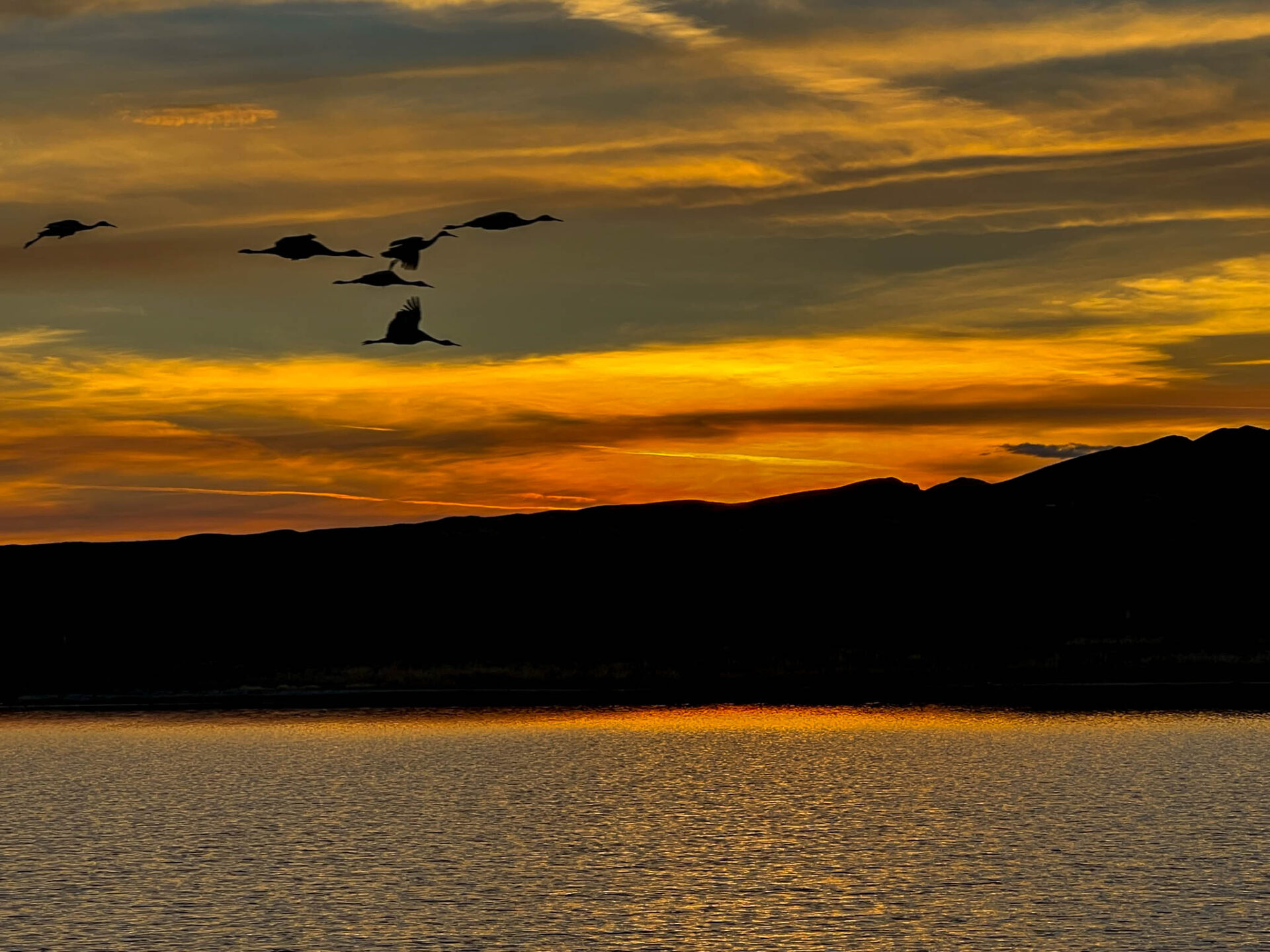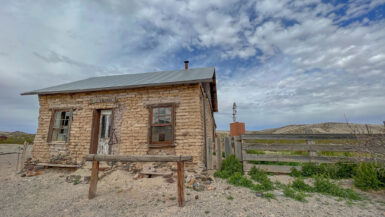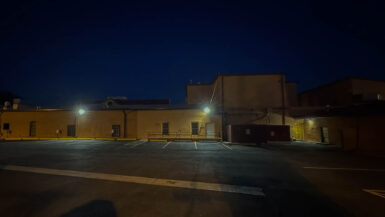Plan your visit to San Antonio, NM—home to Bosque del Apache’s world-class birding, the Festival of the Cranes, and some of New Mexico’s best green chile cheeseburgers.
Each year, as the fall colors fade and the weather starts to cool in New Mexico—stop laughing, Alaska and North Dakota—tens of thousands of visitors begin arriving at Bosque del Apache National Wildlife Refuge in San Antonio.
These visitors are mostly of the winged variety—cranes, geese, and ducks. A few humans show up too, often looking a bit nerdy, loaded up with enough optics to qualify as a mobile surveillance van.
Some come to San Antonio for the birds. Some come for the legendary green chile cheeseburgers. Most, like me, come for both.
As a “craniac” who once helped raise endangered cranes in captivity at the International Crane Foundation, I’ve been known to make the pilgrimage to the annual Festival of Cranes on multiple occasions to visit my old pals. In other words, yes—I’m one of those aforementioned nerds.
So, what’s it like to visit San Antonio and Bosque del Apache? I’m glad you asked.

Table of Contents
A Little History of San Antonio, NM: Saints, Settlers, Hotels & Cold War Secrets
About 70 minutes south of Albuquerque along I-25, you’ll arrive in San Antonio, New Mexico—a tiny agricultural town of fewer than 100 people. On the surface, it might seem like a quiet detour between Socorro and Bosque del Apache National Wildlife Refuge, but it holds more history than many towns ten times its size.
Long before Spanish colonists arrived, the Piro people—a Puebloan culture—lived along the banks of the Rio Grande. They built villages, cultivated crops, and sustained vibrant communities for centuries in the fertile river valley. By the 1600s, their pueblos had become centers of trade and interaction with newly arrived Spanish settlers. While early relations were relatively cooperative—the Spanish even named nearby Socorro in recognition of the “aid” provided by local tribes—tensions escalated over time. Spanish mission efforts, combined with increasing pressure from Apache raids, strained the region. The name “Bosque del Apache” (“Woods of the Apache”) refers to the Apache groups who camped and hunted in the cottonwood groves along the river. By the late 1600s, the Piro population had sharply declined due to disease, displacement, and conflict, with many survivors eventually relocating to what is now El Paso.
The name San Antonio was given during the Spanish colonial era, in honor of Saint Anthony of Padua—a beloved Catholic saint known as the patron of lost things, travelers, and the poor. Naming towns after saints was a common tradition among Spanish explorers and missionaries. So, while the town may be best known today for green chile cheeseburgers and birders with long lenses, its name has spiritual roots that go back centuries.
Fast-forward to the late 1800s, and San Antonio quietly made national history again as the birthplace of Conrad Hilton, founder of Hilton Hotels. Conrad was born here on Christmas Day in 1887, so he probably got short-changed on birthday gifts each year. His father ran a general store that was partially converted into a 10-room hotel, giving young Conrad a front-row seat to the world of business and hospitality. He took those early lessons and built a global hotel empire. Not bad for a kid from a dusty little crossroads in central New Mexico.
San Antonio found itself connected to world history once again in the 1940s, thanks to its proximity to the Trinity Site, where the first nuclear bomb was detonated on July 16, 1945, as part of the Manhattan Project. Located just 28 miles southeast of town, the test changed the course of history. While San Antonio wasn’t directly involved, it became a gathering spot for nearby scientists and military personnel.
Today, the Trinity Site is located within White Sands Missile Range and opens to the public once a year. In 2025, that date is currently set for October 18, but be sure to check the official WSMR site for updates, as the schedule may change. I cheated a little and got to see Trinity Site outside of the public viewing date (and outside the fence that encloses the monument), thanks to a job I had at White Sands Missile Range. But that’s a story for another time.
Let’s get back to birds.
Bosque del Apache National Wildlife Refuge: Birding Bliss in the Desert
This is the reason birders flock to San Antonio.
Bosque del Apache National Wildlife Refuge is a globally renowned birding hotspot, with over 400 species recorded on eBird. Each winter, from November to January, tens of thousands of sandhill cranes, snow geese, and Ross’s geese fill the skies, fields, and wetlands. If you’re looking for sheer spectacle—massive flocks, thunderous takeoffs, and bugling calls that echo across the marsh—this is the season to visit.
If you’re more into species variety than sheer numbers, aim for late April or early May during migration season. To help you with that, the Friends of Bosque del Apache hosts an annual Spring Migration Celebration in May of each year, featuring guided birding trips and workshops. The annual Spring Migration Celebration offers birders and non-birders a chance to explore the incredible diversity of spring migrants passing through the refuge.
The crown jewel event? That would be the Festival of the Cranes, an annual celebration honoring the return of the sandhill cranes to Bosque del Apache. The 36th Festival of the Cranes is scheduled for December 3–7, 2025. This event draws birders, nature photographers, and curious newcomers with workshops ranging from wildlife photography to bird identification. The festival offers a unique opportunity to experience the refuge’s wildlife up close and learn from experts in the field.
The Refuge itself is incredibly accessible. A 12-mile auto loop, split into the Marsh Loop and Farm Loop, lets you cover a lot of ground from the comfort of your car—perfect for lazy naturalists. Start at the visitor center, where the friendly staff can point you toward the best birding spots based on the time of year. Then cruise the loop, stopping at observation platforms or pulling over whenever something flaps, hops, or honks.
Expect to see everything from cranes and coyotes to turtles and hawks, as well as birders bundled in puffy jackets, wide-brim hats, and optics that cost more than their cars. Whether you’re new to birding or a lifelong “craniac,” this place delivers.



Roosting Options for Humans: Where to Stay Near Bosque del Apache
Unless you’re a bird, San Antonio doesn’t offer many lodging options. Most folks drive about 10 miles north to Socorro (population ~9,000), which has a wider selection of hotels and motels. But if you’re hoping to stay closer to the action—there are a few Airbnb options right in San Antonio worth checking out.
A personal favorite of mine is Fite Ranch, a working cattle operation that also offers three guest rooms. Don’t worry—you won’t be sharing your room with livestock; the cattle are kept in a different part of the property. In fact, my stay was surprisingly quiet, with peaceful views of the surrounding Chihuahuan Desert and no mooing in earshot… although I would’ve actually enjoyed that.
If RVing or camping is more your style, San Antonio has a few close-to-the-Refuge options: Bosque Birdwatchers RV Park, Chupadero Mountain View RV Park, and San Antonio Riverine Park. They’re all pretty basic, but their proximity to Bosque makes them popular among early risers with binoculars. Just be prepared for an early morning wake up call from the train that passes by. But since you’re likely a birder, you’ll probably be up early anyway.
The Great Green Chile Cheeseburger Showdown: Where to Eat in San Antonio, New Mexico
Okay, it’s time to bring out the boxing gloves—because in San Antonio, New Mexico, green chile cheeseburgers are a serious subject. Two legendary spots have long battled it out for burger supremacy: the Owl Bar & Café and the Buckhorn Tavern.
Both serve up green chile cheeseburgers that have sparked family feuds and road trip detours. And both have been around for decades. So… who takes the crown?
Let’s find out.
The Owl Bar & Café: Where New Mexico’s First Green Chile Cheeseburger Was Hatched
San Antonio is home to the Original Owl Bar & Café—“original” being the key word, since a second location opened in Albuquerque. The Owl has been slinging burgers since 1945, when Frank and Dee Chavez opened it inside the grocery store of Dee’s father, Jose Miera. Sadly, Frank was murdered in 1976 during a robbery at his home. After his death, their daughter Rowena and her husband Adolph Baca took over and ran the place for over 40 years, eventually opening the Albuquerque location in 1987. In 2018, their daughter Janice Argabright became the fourth generation to carry on the tradition.
As a fun aside, the bar inside the Owl reportedly came from Conrad Hilton’s first rooming house in San Antonio, and it’s been propping up elbows ever since—from local regulars to well-known names who’ve heard about this iconic New Mexico stop.

The Owl claims it served New Mexico’s first green chile cheeseburger back in 1948, and they’re still using the original recipe today. As their website proudly declares: “This stuff ain’t bought! We grind our own beef and prepare the secret green chile sauce each day.” If burgers aren’t your thing, the menu also includes breakfast burritos (served until 10:30am), sandwiches, steaks, and desserts. The Owl is open Monday through Saturday from 8am to 8pm, though hours can change seasonally—so it’s always a good idea to check their website before heading over.
Buckhorn Tavern: Burgers, History, and a Bobby Flay Beatdown
The Buckhorn Tavern in San Antonio, New Mexico, boasts a rich history that dates back to 1918 when Miguel Olguin established the original establishment across from Conrad Hilton’s first hotel on Highway 1. Initially serving coal miners from nearby areas, the tavern became a community hub. In 1943, Miguel’s son, Manuel “Manny” Olguin, relocated the Buckhorn to its current location, transforming it into a multifaceted venue offering burgers, gasoline, haircuts, and even hosting impromptu boxing matches—a nod to Manny’s boxing background in the army.
The Buckhorn’s green chile cheeseburgers have garnered national acclaim over the years. In 2005, GQ Magazine ranked their burger as the seventh best in America. The tavern gained further recognition in 2009 when celebrity chef Bobby Flay featured it on his show “Throwdown with Bobby Flay,” where he challenged then-owner Bobby Olguin and was bested in a burger cook-off. This event led to New Mexico’s Governor Bill Richardson declaring July 24 as New Mexico Buckhorn Tavern Day, highlighting the establishment’s contribution to the state’s culinary fame.
In 2019, Ernie and Stephanie Sichler, along with their daughter Morgen, took over the Buckhorn Tavern, driven by a passion to preserve its legacy. With deep-rooted ties to the San Antonio community, the Sichlers continue to serve up burgers using the original Olguin family recipes from 1943, along with sandwiches, salads, and classic New Mexican fare.
Please note that the tavern is walk-in only and does not accept reservations. The Buckhorn is open Monday – Saturday, but the hours vary depending on the season, so check their website for details.

The Great Green Chile Cheeseburger Taste Test: Owl vs. Buckhorn
And now, the inevitable question: Which one is better?
To get to the bottom of it, I conducted an extremely scientific, highly controlled experiment—otherwise known as eating two takeout burgers in my car at night. I ordered one burger from each place, skipping the cheese (I know, I know, but I’m not a cheese guy) and sticking with lettuce, tomato, and green chile. Presentation? Let’s just say the photos aren’t winning any food styling awards—but trust me, the burgers tasted way better than they looked under my dashboard light.


Here’s what I found:
- Meat: Both had good flavor, but the Buckhorn patty was a bit bigger and felt slightly more substantial.
- Bun: Nothing fancy at either spot, but the Buckhorn’s is slightly bigger, which makes sense given the heftier patty. There’s a good chance that your burger bun will fall apart at either place, so plan accordingly. I didn’t plan accordingly, which resulted in the opportunity to wear some of the burger juice and contents on my pants.
- Cheese: I skipped it, but a local birder swore Buckhorn’s is better. She seemed trustworthy and knew her birds, so I’m taking her word for it.
- Green Chile: Both were tasty, but Owl’s had slightly more heat, which gave it the edge for me.
- Price: Owl Café burger rang up at $7.22, Buckhorn’s was $8.99 (both prices burger only).
I didn’t order fries, drink, or anything else as I figured it would be hard enough for me to eat two burgers. And I was right about that. I ate about 2/3 of each before throwing in the towel—and mopping up burger juice and contents from my pants.
The Verdict? Honestly, you can’t go wrong with either. They’re both solid, flavorful, and worthy of their reputations. Okay, I know that’s a lame, diplomatic answer and not what you wanted to hear. But since you’re backing me into a corner, I’ll say this: based on a sample size of one, eaten in the front seat of my car, I’ll give the win to Buckhorn. That said, I’ll probably just alternate between them on future visits. It’s the only way to keep the peace—and I’m a peacemaker by nature.
Bonus Treat: San Antonio General Store
For dessert—or just a quick sugar fix—swing by the San Antonio General Store. They serve Dreyer’s ice cream, smoothies, and homemade fudge (when it’s not sold out). I went with a scoop of Dulce de Leche in a waffle cone, and it hit the spot.

What to Do in San Antonio (Besides Eat and Birdwatch)
Truth be told, birding is the main attraction here. With Bosque del Apache National Wildlife Refuge just down the road, most visitors come to see the sandhill cranes, snow geese, and other migratory species that make this spot world-famous.
But there’s more to do than just stare at the sky. You can also hike one of the refuge’s scenic trails and keep an eye out for coyotes, rabbits, reptiles, and insects—some of which are just as entertaining to watch as the birds.

Photography is another major draw. Between the dramatic light at sunrise and sunset, the wide-open landscapes, and the ever-moving wildlife, it’s hard not to feel like a decent photographer—even if your camera fits in your pocket. (For the record, every photo in this post was taken on my iPhone.)
And when the sun goes down or the cranes settle in, you can always kick back at The Owl, The Buckhorn, or both—swapping stories with birders, bikers, ranchers, and other friendly folks passing through.
Stay tuned for a few of my favorite shots from my visits to Bosque del Apache NWR. Just don’t expect National Geographic quality. Let’s call it… “iPhone realism.”





Why It’s Worth the Stop
If you’re planning a road trip through central New Mexico, San Antonio and Bosque del Apache deserve a spot on your itinerary. Whether you’re a lifelong birder, a burger aficionado, or just someone looking to experience the rhythms of a slower, wilder world—you’ll find something here that sticks with you.
And if you see a guy with binoculars and a green chile stain on his pants, stop and say hi. There’s a good chance it’s me.
Thought for the Week
This week’s quote comes from Marcel Proust (1871–1922), one of the most influential literary voices of the 20th century. Proust was a French novelist, essayist, and critic best known for his monumental seven-volume work, In Search of Lost Time (À la recherche du temps perdu). Across more than a million words, he explored memory, time, and the subtle emotional landscapes of everyday life—turning the smallest moments into profound revelations.
Proust had a gift for noticing the things most people overlook: the sound of footsteps in a quiet hallway, the scent of a pastry dipped in tea, the feeling of watching the world shift ever so slightly. His writing reminds us that discovery isn’t always about far-off places—it’s about learning to see the familiar with new perspective.
That’s why his words feel so fitting for a place like Bosque del Apache. You don’t have to travel across the world to experience awe. Sometimes it’s just a matter of pulling off the highway, standing still, and letting yourself really look—and really listen.
“The real voyage of discovery consists not in seeking new landscapes, but in having new eyes”.
— Marcel Proust
Thanks for reading and happy travels!
Mark (The New Mexico Travel Guy)

Mark Aspelin, The New Mexico Travel Guy (www.newmexicotravelguy.com), is a travel writer, conservation biologist, project manager, and author of two books. He’s visited over 100 countries and all 50 U.S. states—just enough to land in the Travelers’ Century Club and make choosing a favorite place nearly impossible. He’s currently on a questionable mission to visit every town in New Mexico (there are over 500) and write a story about each one, with plans to wrap it up sometime before his early to mid 100s. Mark balances his writing with conservation and project work from his home base in the East Mountains near Albuquerque, New Mexico.





Leave a reply